The Orang Asli or aborigines of Peninsular Malaysia consists of 19 tribes and can be divided into three ethnolinguistic groups, i.e. Semang (Negrito), Senoi (Sakai) and Proto-Malay. Only two sub-groups of Senoi branch; the Jah Huts of Jerantut, Pahang, and the Mah Meri od coastal Selangor, are reknown for their skill of carving sculptures and masks or topeng.
The former display their mastery and ingenuity at sculpture, whereas the latter in masks and sculptures. Being animists, the wood carving is manifestations of their primitive beliefs of the supernatural world. Their masks are their heritage in so far as myths and legends are told via them. Characters in these stories are outward forms of various ancestral spirits, called moyang, who are either humans, animals or semi-humans. Incidentally, all masks are called moyang. The masks are used during spiritual dances such as joh and tengkeng, as well as sakat buang, a practice that uses the mask to cast away diseases from the sick.
The tradition of carving mask is predominantly a male pastime activity, passed on from father to son. Each carver specialized in specific spirits as there are over 460 types of masks. While Museum of Asian Art has collecting 111 pieces of masks from various types of moyangs. No mask of the same spirit is identical as each carving is individualistic. Very often, each type of mask consists of a pair of male and female spirits. It takes about 2-4 weeks for a mask to be completed. Only two types of mangrove wood are used for carving; the nyireh batu (Carapa moluccensis) and the tingkong or pulai (Alstonia Spatulata, Blume). The former, the dark reddish brown hardwood is used mainly for sculptures and sometimes for masks, while the latter, the beige coloured wood, is used only for mask as it is lighter and softer
The art of making masks have been in existence since the Paleolithic age. Early discoveries made at 30,000 years-old archeological sites in Teyjat, Dordogne and cave paintings in Lourdes, France indicate that people have been masks depicting faces of wild and haunted animals. It is believed that the one who wears such a mask would be granted extraordinary powers.
Masks may be divided into two main categories namely anthropomorphic which displays human characteristics and theriomorphic, displaying animal characteristics. Another important aspect to be taken into account is the process of creating masks. Anthropologists discovered that these masks, especially those made of wood, were made by special craftsmen of the community. Masks created for rituals relating to death, spirit worship, casting away evil spirits and curing of diseases caused by the unseen forces are usually designed to look spooky or frightening, often with big boggling eyes, unkempt hairdos, long fangs, and even horns. On the other hand, masks for thanksgiving ceremonies are created with more appealing look using bright colors with a big smile and less scary fangs.
Masks are created in various sizes. Those used for annual ceremonies, festivals and diseases-curing rituals are made to fit the size of human faces, i.e. between 6 to 8 inches. However, masks of bigger sizes as a large as two feet in height have also been discovered. Due to its impractically for usage, a mask of this size rarely designed except for some specific purpose or significance. Within the Malay community in Malaysia, the mask wearing culture has never been significant. If ever, it would only be found in modern theatrical performance bearing no religious significance whatsoever. Today, masks are created as a art, being made to look more attractive or frightening simply for aesthetic reasons to be given as souvenirs rather than to frighten away evil spirits.
The Jah Hut tribe in rural Pahang make masks too. Two groups of people – the orthodox elders, still wear masks with strong beliefs in taboos and special powers of the unseen, while the other generation creates masks for commercial purpose through constantly producing new designs. Masks are still used during special occasions amongst the Javanese and the Balinese communities in Indonesia. However, the presentation held to day are mostly to attract tourist.
Today, masks are mainly used as decorations in art galleries or living rooms of modern urban residences. How or why masks were originally created has never been thoroughly scrutinized. To those actively involved in the preservation of culture in this country, this could be a challenge to be undertaken.
Hudo is a mask m ade and worn by some of the indigenous people of Sabah and Sarawak namely the Iban, Kenyah and Kayan tribes either for cult u ral purposes of simply for entertainment. The mask is worn at the beginning or during the harvest festivals and also to welcome guests to their homes.
The Dayak women of the Kenyah and Kayan tribe, wear Hudo to scare little children who are still playing outside at sunset. The wearer becomes the temporary mediator between his real self and the spirits. These masks are also worn by spiritual healers when conducting rituals and also during funerals.
The Museum of Asian Art has 16 Hudos presented by Mr. Nelson Tan of Sarawak.
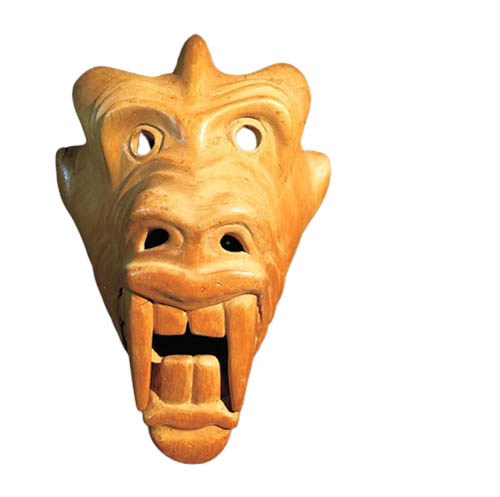
Sembuar air or whirlpool develops when the sea water spins around in the middle of the sea. A fisherman was once caught in a whirlpool and did not return for seven days. Then the worried son received a sign from the father,
“If you go to the seaside, bring seven coloured items, washed white rice, yellow rice, areca leaves, tobacco, and areca nuts.”
After sprinkling rice into the sea, Moyang Sembuar Air left his father’s “clothes” on the seaside the next morning. He then understood that his father had been swallowed by the whirlpool.
UM.80.328
.jpg)
Based on oral tradition, Moyang Ampai was about two brothers who studied magic and wanted to test each other’s powers. The younger brother was declared the winner when what he spat into the sea turned into a jellyfish or ampai.
UM.80.396
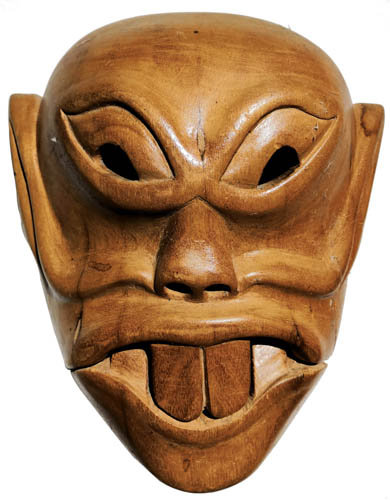
Once there was an evil human wife who was married to a loving naive ape. She was described to have a buruk belakang for pretending to be very kind towards the hardworking husband. She turned her back on the husband when she stole his treasures before setting their treehouse on fire.
UM.80.320
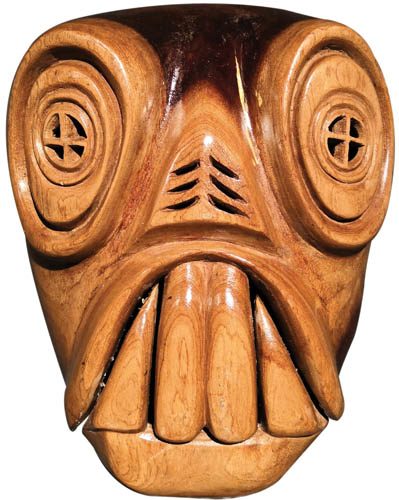
It was a stormy night when a family resting at an old house came face to face with a moyang. It emerged from an old dapur or stove that had overturned. This moyang had enormous teeth, eyes a long tongue and long nails. The father captured her by twirling her hair around his arm. After one whole night, he released her. That night he slept, and she came into his dream. The moyang praised him for his bravery and left a gentle reminder to light a fire on stormy nights, even as small as a torch. So, he carved a mask to remember her as Moyang Dapur.
UM.80.393
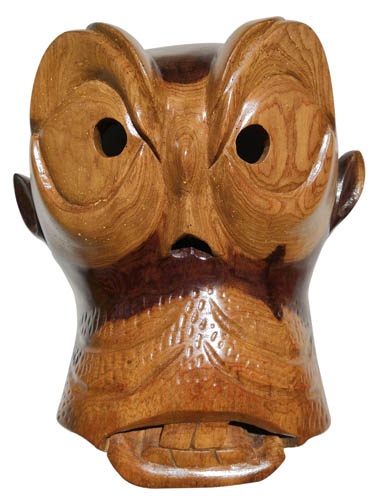
It was told that the origin of the Moyang Katak was during one of the ceremonial battles between villages. One of the battling villages presented a riddle in a poem:
“Kisip-kisip daun sipoh, katak tidak berekor”
Unfortunately, the other village did not know that it was about sipoh leaves that magically turned into a frog.
UM.80.359
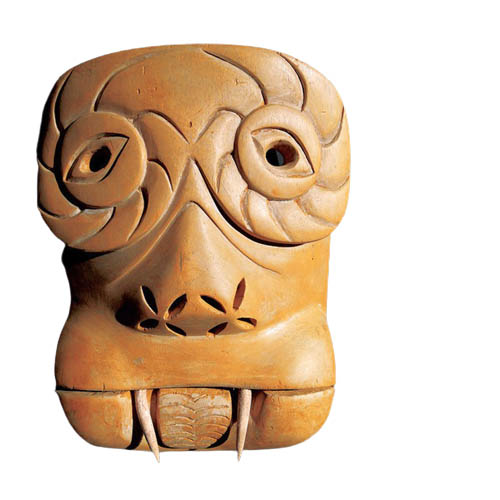
It was told that a man suffering from a terrible skin disease was cursed to become a lembu or cow. Because he could be easily convinced, rather naive too, he believed when a moyang said,
“You are a cow, you can’t eat rice, if you eat rice your disease won’t be healed. Try eating some grass,”
True enough his skin became better and better, but his ears became longer and longer. So, when given a choice, he decided to remain as a cow and promised Moyang Lembu not to be afraid of humans.
UM.80.336
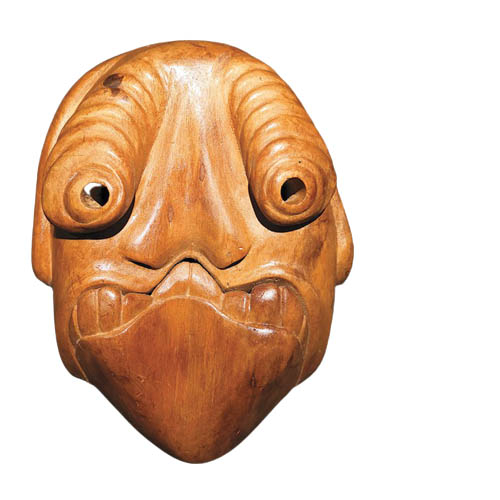
A pelangi or rainbow appears when the Rainbow Princess is bathing at the well. She is a protector who warns humans that the rain or a storm is coming. She is also able to stop the rain. Pointing with the finger at the rainbow is a taboo, especially for pregnant mothers. The pointed finger can be maimed, or something will happen to the child in the womb.
UM.80.353
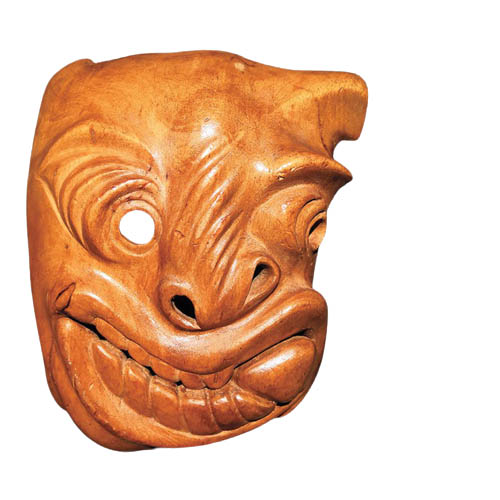
According to Mah Meri belief, before leaving the house to go to the jungle or attend to outside matters, he should first eat a bit of the nasi or rice or any food left, especially when leaving before senjakala or dusk. This will prevent disturbance by Moyang Tenung Nasi. If no food is left, it is adequate to touch the spoilt food just before leaving the house.
UM.80.343
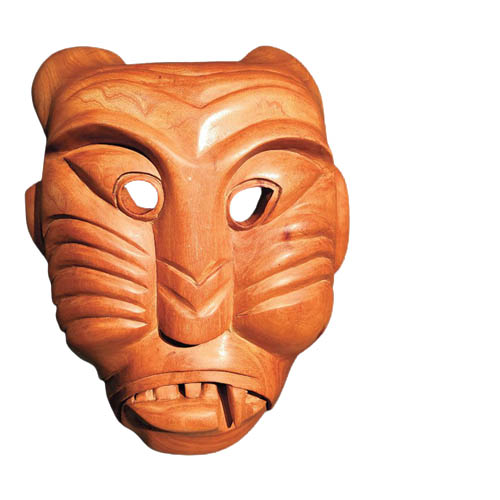
It began when a man went fishing for ikan puyu or climbing perch craved by his pregnant wife. All day he was disturbed by the sound “Pot! Pot!” that went on till dusk. Frustrated he said in anger, “Pot! Pot! Since you are so busy pot-ing away, go pierce that wife!” So Moyang Pot did exactly that! After resembling the dead wife, it morphed into a tiger. UM.80.351
UM.80.353
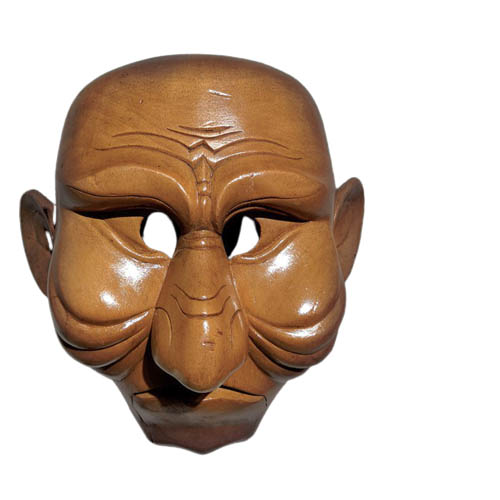
During a ceremony to welcome the paddy spirits, a moyang saw villagers performing a dance ceremony called sewang. So, he wanted to join in the fun. When a villager saw him, he informed the shaman. The shaman decided to invite the moyang to join and asked for his name. “I am Tok Naning. Can’t you see? I have sunken eyes and my head is spinning.” So, he was then named after his looks. Tok is a title of reverence and naning means eyebrows. The sewang dancing troup then created a song about the moyang that goes like this, “Tok naning mato kelehor, kol pening met koho,” Tok Naning was respected by the villagers. Whenever there was a sewang ceremony, they will ask the moyang to prevent any dizziness when they perform the dance. This is because the dance routine involves many repetitions of circling movements. UM.80.386
UM.80.353
Last Update: 01/03/2022